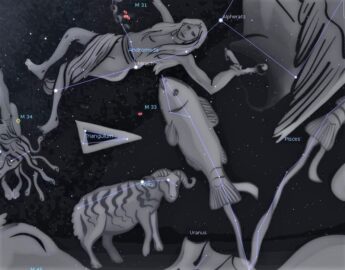This Week’s Sky at a Glance, 2023 Sept. 23 – Sept. 30
This Week’s Sky at a Glance, 2023 Sept. 23 – Sept. 30
Small constellations tend to get overlooked unless, like Delphinus the Dolphin, they have fairly bright stars or an eye-catching pattern. Aries the Ram and cleverly named Triangulum aren’t quite as pretty as Delphinus but they do get noticed. Okay, Triangulum isn’t pretty but it is acute, situated below Andromeda in mid-evening. Below it is brighter Aries, which resembles a somewhat squashed triangle.
In mythology, the god Hermes sent a flying, golden ram to rescue a prince who was being sacrificed to end a famine. The prince showed his gratitude by slaughtering the ram and giving its fleece to a man in exchange for his daughter’s hand in marriage. The Golden Fleece later became the quest of Jason and the Argonauts. Over 2000 years ago the Sun was in Aries on the first day of spring, and the vernal equinox is still called the First Point of Aries despite having moved into the constellation Pisces long ago.
Triangulum is not associated with an exciting tale from mythology but at times it had been regarded as a tribute to both the Nile Delta and the island of Sicily. I use the tip of the triangle as a reference for locating the Triangulum Galaxy, also called M33. It is almost halfway and a tad to the right of a line from the tip to orange Mirach in Andromeda. Smaller and slightly more distant than the nearby Andromeda Galaxy (M31), this face-on spiral galaxy is dim but attainable with binoculars in a reasonably dark sky.
This Week in the Solar System
Saturday’s sunrise in Moncton is at 7:07 am and sunset will occur at 7:15 pm, giving 12 hours, 8 minutes of daylight (7:12 am and 7:20 pm in Saint John). Next Saturday the Sun will rise at 7:16 am and set at 7:01 pm, giving 11 hours, 45 minutes of daylight (7:20 am and 7:06 pm in Saint John). This Saturday at 3:50 am the Sun crosses the equator, heading southward, to begin our autumn season.
The Moon is at first quarter on Friday, September 22, leading us into Fall Astronomy Day. It passes near Saturn on Tuesday, Neptune on Thursday, and it is full next Friday. Brilliant Venus rises around 3:45 am midweek, followed by Mercury two hours later. The steep angle of the ecliptic on early autumn mornings places them higher in the sky for better viewing. Saturn is at its best for observing in late evening, and Jupiter rises around 9:45 pm midweek.
The RASC NB star party at Kouchibouguac National Park takes place on Friday and Saturday, September 22-23. Also, Astronomy Day public observing will be held at the Irving Nature Park in Saint John on September 22 from 8 – 11:30 pm, with a back-up date of September 23.

